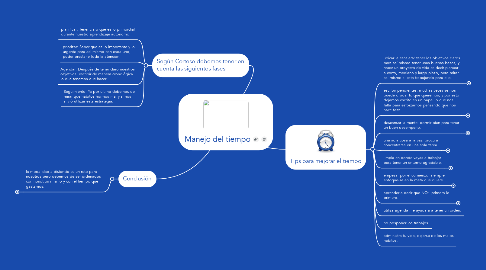
1. Según Cortese debemos tener en cuenta las siguientes fases
1.1. planificar: Tener claro que es lo primordial durante nuestro aprendizaje autónomo.
1.2. priorizar: Saber que es lo importante y lo urgente para así mismo con cada uno, poder prestarle toda la atención.
1.3. Agendar: Después de tener claro nuestros objetivos, escribir de manera cronológica lo que tenemos que hacer.
1.4. Seguimiento: Ya por ultimo debemos de mirar que hábitos hicimos mal y si nos sirvió utilizar esta estrategia.
2. Tips para mejorar el tiempo
2.1. ubicar la escalera: tener los objetivos claros para así mismo tener unas buenas bases, y hacer un proyecto de vida es decir planear a corto, mediano y largo plazo, pero mirar así mismo si esta trabajando para ello.
2.1.1. Situational Analysis / Drivers
2.1.1.1. What is driving us to do this?
2.1.1.2. SWOT Analysis
2.1.1.2.1. Strengths
2.1.1.2.2. Weaknesses
2.1.1.2.3. Opportunities
2.1.1.2.4. Threats
2.1.1.3. Customer Findings - What have we learned from customers?
2.1.2. Competitive Analysis
2.1.2.1. Do we have competitors and threats in these target markets with the proposed offerings?
2.1.2.2. What are our competitors doing and how are they positioning?
2.1.2.3. How do we position against each competitor?
2.1.3. Target Customer(s)
2.1.3.1. Buyer Profile
2.1.3.1.1. Title
2.1.3.1.2. Industry
2.1.3.1.3. Geography
2.1.3.1.4. Business Size
2.1.3.2. Influencer Profile
2.1.3.3. User Profile
2.1.3.4. What do customers want and need?
2.1.3.5. What business problems do each of these customers have?
2.1.4. Customer Segmentation
2.1.4.1. Which customers or sets of customers do we sell to?
2.1.4.2. What are the target market segments that we want to go after?
2.1.4.3. What are the distinct problems for each segment of the market?
2.1.5. Total Available Market
2.1.5.1. New Prospects
2.1.5.1.1. How much of each target segment have we penetrated?
2.1.5.1.2. How much opportunity is available in each target segment?
2.1.5.2. Existing Customers
2.1.5.2.1. Can we up-sell existing customers?
2.2. escribir pendientes: muchas veces se nos puede olvidar lo que queremos, y por esto dejamos escrito en un papel lo que nos falta para esforzarnos pensando que nos hace falta.
2.2.1. Service Offer
2.2.1.1. What are we selling?
2.2.1.2. Product Definition
2.2.1.3. Pricing
2.2.1.4. Packaging
2.2.1.5. Positioning
2.2.2. Value Proposition
2.2.2.1. What is the Value Proposition to the Customer?
2.2.2.2. What pain are we solving?
2.3. descansar la mente: dormir bien para tener un buen desempeño.
2.3.1. Revenue Forecasts
2.3.1.1. Revenue and P&L Forecast (5 Years)
2.3.1.2. Revenue should be split out quarterly
2.3.2. Cost Analysis
2.3.2.1. Should include a description of the costs in entering this business and profitability analysis
2.3.3. Profitability Analysis
2.3.3.1. P&L for the offer to include gross margin, net income and break even analysis.
2.4. una sola cosa a la vez: procura concentrarse en una sola tarea.
2.4.1. Sales Strategy
2.4.1.1. Direct Sales Strategy
2.4.1.2. Inside Sales Strategy
2.4.1.3. Channel Sales Strategy
2.4.2. Partner Strategy
2.4.2.1. Channel Strategy
2.4.2.1.1. What 3rd party channels should we consider for reselling this service?
2.4.2.2. Technology Partnerships
2.4.2.2.1. What technology vendors (if any) do we need to work with to execute on this plan?
2.4.2.3. Solutions Partners
2.5. limpia en donde vayas a trabajar para tener un entorno agradable.
2.5.1. Positioning & Messaging
2.5.1.1. What is the key messaging and positioning for the service offer? (Pain, alternatives, solution)
2.5.1.2. How do we communicate internally?
2.5.1.3. How do we communicate externally?
2.5.2. Promotion Strategy
2.5.2.1. Marketing Programs (Installed base versus new prospects)
2.5.2.2. Advertising (Publications, etc.)
2.5.2.3. Analyst Relations (Target Analysts)
2.5.2.4. Public Relations
2.5.2.5. Events (Trade shows, SEO/SEA, Seminars)
2.5.2.6. Webinars
2.5.3. Demand Generation & Lead Qualification
2.5.3.1. How do we generate and qualify new leads for the target offer?
2.5.3.2. Prospect Lists
2.5.3.3. Key Questions to Ask
2.5.3.4. Sales Collateral
2.5.3.5. Presentations
2.5.3.6. Data Sheets
2.5.3.7. White Papers
2.5.3.8. ROI Tools
2.5.3.9. Other Sales Tools (web site, etc.)
2.6. empezar por el comienzo: siempre enfoque-se en la meta que quiere.
2.6.1. Numbers, budget, waterfall, break-even (cost>leads>trials>deals)
2.6.2. Sales Programs
2.6.3. Accelerated Learning Strategy, Controls, Metrics
2.6.4. Include feedback loops
2.6.5. Include financial metrics (definition of success)
2.6.6. Pipeline reports, etc…
2.7. aprender a decir que NO: primero lo primero.
2.7.1. M&A?
2.7.2. Risk Analysis & Mitigation
2.8. utiliza agenda , le ayudara a tener un orden.
2.9. no posponer los trabajos.
2.10. administra tu vida, dejarse de los malos habitos.
3. Conclusión
3.1. la modalidad a distancia es un reto para nosotros pero debemos de ser ordenados con nosotros mismo y con el tiempo que gastamos.
3.1.1. Training
3.1.2. Channels
3.1.3. International
3.1.4. Public Sector
3.1.5. Sales
3.1.6. Marketing Communications
3.1.7. Product Management
